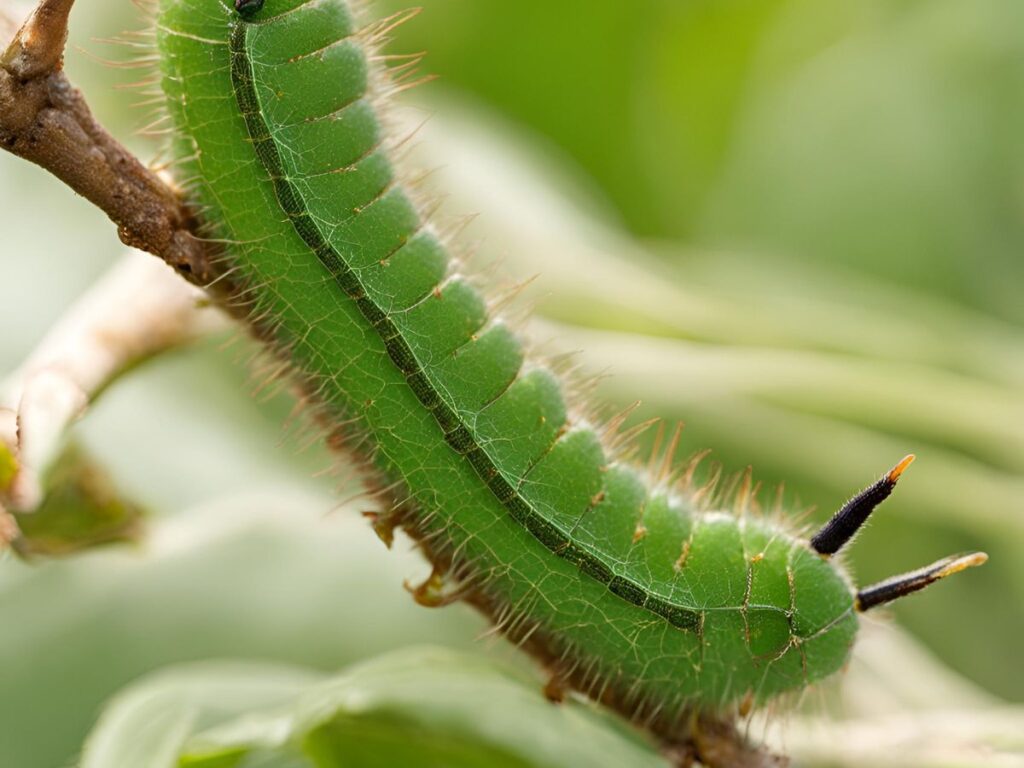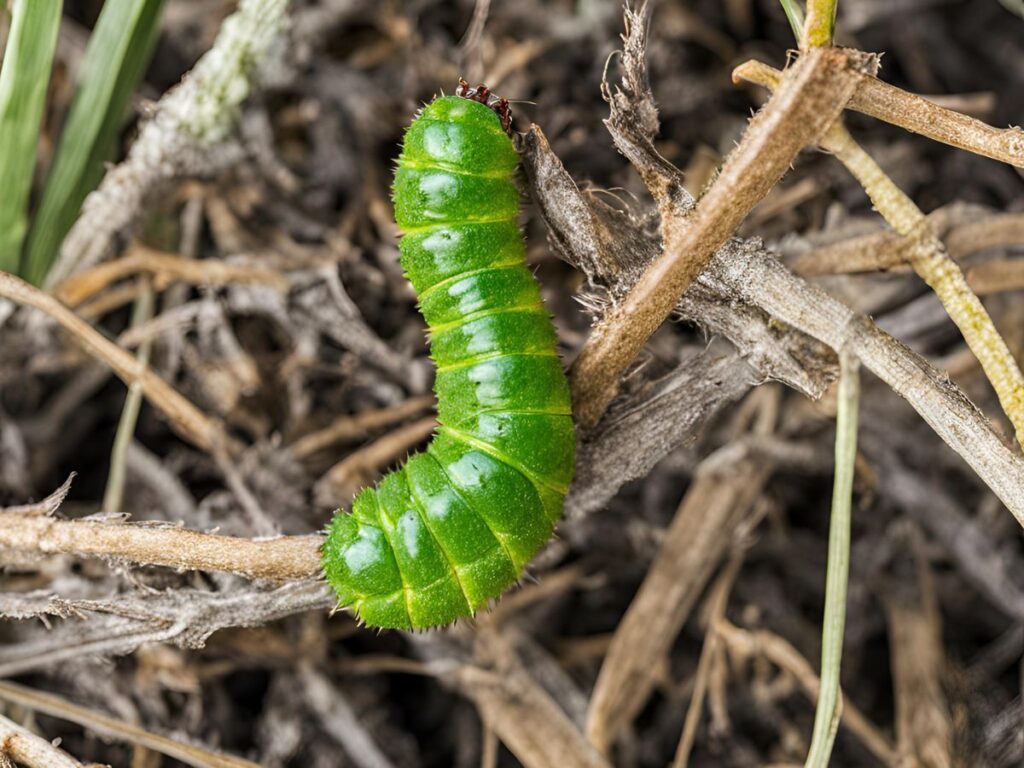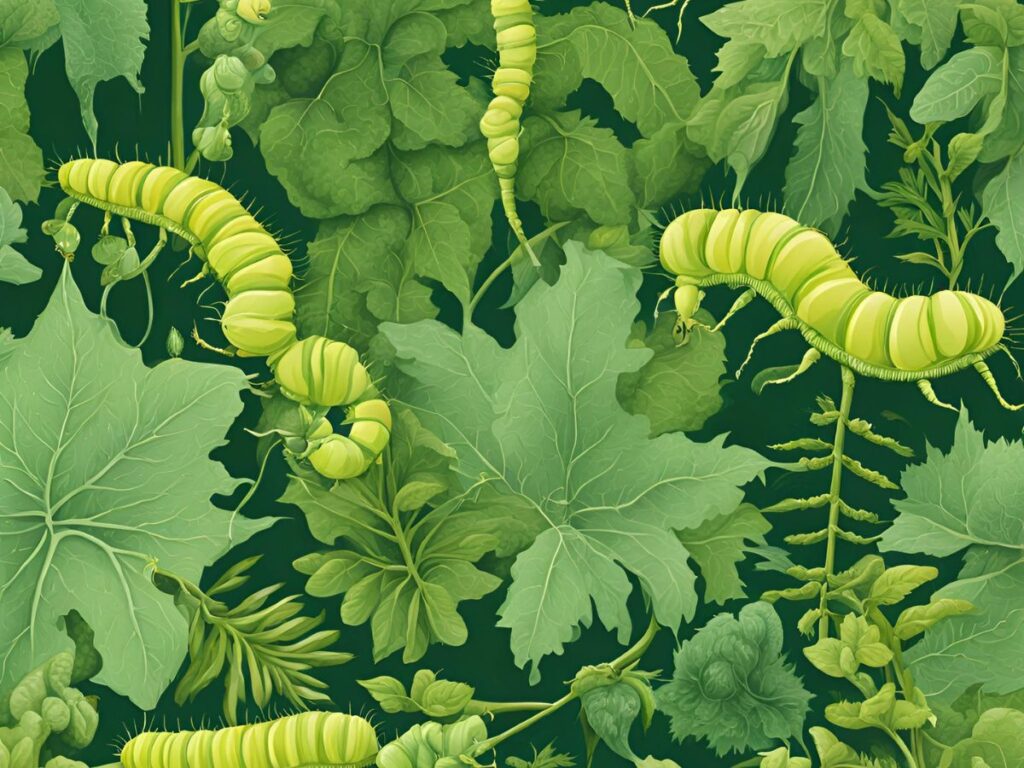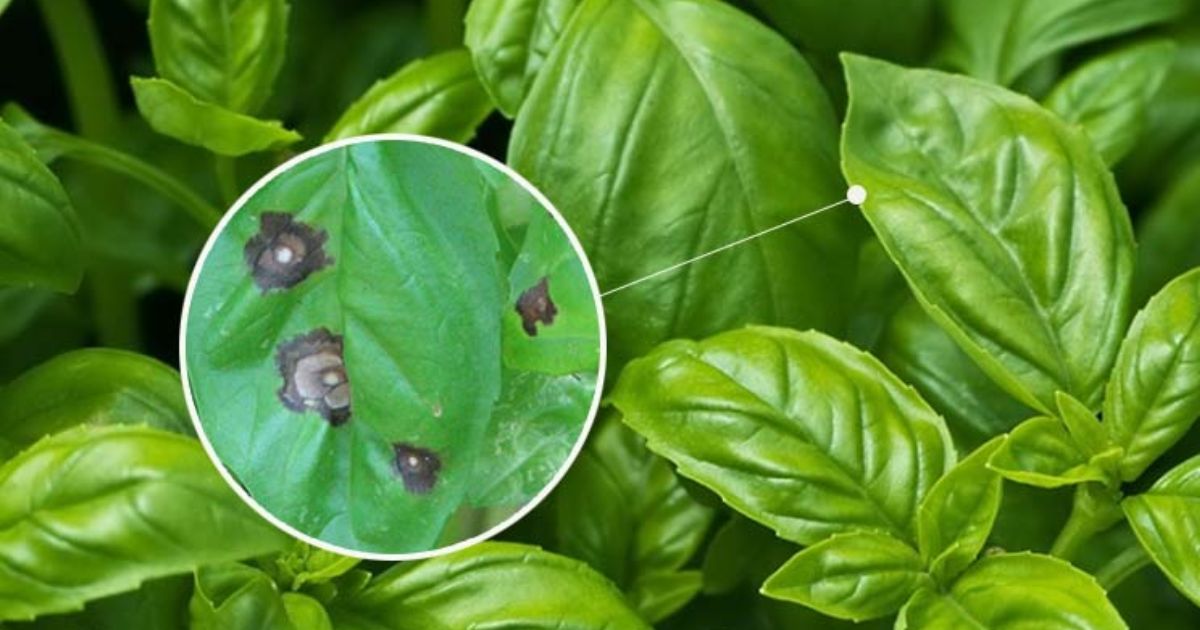Green caterpillars are common in gardens, fields, and forests, often blending seamlessly with their leafy surroundings. These fascinating creatures are in the larval stage of various butterflies and moths, playing a crucial role in the ecosystem. However, not all green caterpillars are alike; they come in multiple shapes, sizes, and patterns, making them intriguing and challenging to identify. This article, “Types of Green Caterpillars: How to Spot and Identify Them,” aims to guide you through spotting and distinguishing between different species of green caterpillars.
By learning to identify these caterpillars, you’ll gain a deeper understanding of the biodiversity in your environment and their importance in nature. Whether you’re a gardener looking to protect your plants or a nature enthusiast curious about the world, recognizing the various green caterpillars can enhance your outdoor experiences. Let’s dive into the world of green caterpillars and discover how to spot and identify them effectively. Damping Off in Seedlings
What Are Green Caterpillars?
Green caterpillars are the larval stage of various species of butterflies and moths. Characterized by their green coloration, these caterpillars feed on leaves and other plant materials. Their vibrant green color often helps them blend in with their surroundings, providing an effective camouflage against predators. In addition to helping them survive, this adaptability enables them to flourish in different environments, from gardens to forests.
Many caterpillars are green due to their diet, primarily green plant leaves. The pigments from the plants they consume contribute to their coloration, making them less conspicuous to birds and other predators. Additionally, their green hue helps them stay hidden among the foliage, an essential survival tactic during this vulnerable life cycle stage.
As caterpillars, they go through several growth stages, known as instars, before eventually forming a chrysalis or cocoon. Inside this protective casing, they transform remarkably, emerging as either butterflies or moths. This metamorphosis is a critical part of their life cycle and is vital in pollination and the broader ecosystem. Therefore, green caterpillars are fascinating in their developmental journey and essential contributors to the natural world. is a banana a herb
Common Types of Green Caterpillars
There are several types of green caterpillars, each with distinctive features that make them unique. Here’s a look at some common types:

1. Monarch Caterpillar
One of the most well-known caterpillars is the monarch. Though not entirely green, it has striking green stripes and black and yellow bands. These chartreuse caterpillar are typically found feeding on milkweed plants, which provide them with toxins to deter predators. Monarch caterpillars grow up to 2 inches long and are known for their role in the life cycle of the iconic Monarch butterfly.
2. Cabbage Looper
The Cabbage Looper is a white and light green caterpillar lines running down its sides. It gets its name from the looping motion it makes as it moves. These caterpillars are common garden pests, feeding on crops such as cabbage, broccoli, and kale. Their maximum length is 1.5 inches, and they are often found on the underside of leaves.
3. Tomato Hornworm
The Tomato Hornworm is a large green caterpillar identification chart it can be up to 4 inches long. It has white diagonal stripes on its sides and a prominent horn-like projection at its rear end. Tomato Hornworms are voracious feeders and are known to cause significant damage to tomato plants and other nightshade family crops. Despite their destructive nature, they transform into the beautiful Five-Spotted Hawk Moth.
4. Luna Moth Caterpillar
The Luna Moth caterpillar is bright green with small orange spots running along its sides. It can grow up to 3 inches in length and is primarily found on trees such as hickory, walnut, and birch. As they mature, they develop ridges and become plump before pupating into the stunning The Luna Moth is distinguished by its long tails and pale green wings.
5. Eastern Tiger Swallowtail Caterpillar
The Eastern Tiger Swallowtail caterpillar is unique in its green stage, with sizeable false eye spots that resemble a snake’s head. These eye spots help deter predators by making the caterpillar look more threatening. They are often found on host plants like wild cherry, birch, and tulip trees. They change from green to brown as they grow before pupating into the elegant Eastern Tiger Swallowtail butterfly.
Each of these green fuzzy caterpillars has distinctive features that aid in their survival and contribute to the fascinating diversity of the insect world. From their size and markings to their feeding behavior, these caterpillars play crucial roles in their respective ecosystems.
How to Spot Green Caterpillars
Spotting bright green caterpillar requires a keen eye and an understanding of their preferred habitats and behaviors. Here’s how to increase your chances of finding them:
Where to Look for Green Caterpillars
Green caterpillars are commonly found in vegetation-rich environments, such as gardens, forests, and fields. They prefer areas with abundant food sources, like leafy plants and trees. You can often find them in gardens on vegetable plants such as tomatoes, cabbages, and leafy greens. They may be seen in forests on various trees and shrubs, feeding on the leaves. Fields with wildflowers and grasses are typical habitats where these caterpillars hide.
When to Find Green Caterpillars
Green caterpillars are typically more active during the warmer months, from late spring to early fall. The best time to look for them is when they feed, although some species may be more active in the early morning or late afternoon to avoid the heat. Checking plants regularly during these times increases the likelihood of spotting these elusive creatures.
Importance of Careful Observation
When searching for identifying green caterpillars, it’s crucial to approach them carefully to avoid disturbing them. These caterpillars rely heavily on their camouflage for protection, and handling them can expose them to predators or cause unnecessary stress. Instead of picking them up, observe them in their natural habitat. Using a magnifying glass or taking close-up photos can help you get a better look at their details without causing harm.
By understanding their habitats and being mindful of their behavior, you can enjoy observing green caterpillars while ensuring they remain undisturbed in their natural environment.
How to Identify Green Caterpillars
Identifying green caterpillars involves observing various physical characteristics and behaviors. Here are the steps to help you accurately identify them:
1. Observe the Color and Patterns
Start by examining the caterpillar’s color and patterns. Green caterpillars can vary in shades from light to dark green. Look for distinctive markings such as stripes, spots, or unique patterns that may run along their bodies. These patterns are often key indicators of the caterpillar’s species.
2. Check the Size and Shape
Next, measure the length and observe the overall shape of the caterpillar. Some green caterpillars, like the Tomato Hornworm, can grow up to 4 inches long, while others, such as the Cabbage Looper, are smaller. Pay attention to body segmentation and the presence of any protrusions or horns, which can help differentiate between species.
3. Examine the Head and Antennae
Take a closer look at the caterpillar’s head and antennae. The head can vary greatly in size and shape, and some caterpillars, like the Eastern Tiger Swallowtail, have distinctive eye spots near their heads that mimic a snake’s eyes. Antennae may be short and stubby or long and thin, providing further clues to their identification.
4. Identify Host Plants
Green caterpillars often have specific host plants on which they feed. Identifying the plant they are eating can offer a significant clue to the caterpillar’s identity. For instance, Monarch caterpillars are almost always found in milkweed plants, while Tomato Hornworms are commonly seen in tomato plants.
5. Use Field Guides or Apps
For more precise identification, consult field guides with images and descriptions of various caterpillar species. Mobile apps can also help you identify caterpillars by simply uploading a photo. These tools are invaluable for comparing features and confirming the caterpillar’s species.
By taking these actions, you may precisely determine different types of green caterpillar identification chart, enhancing your understanding of the natural world around you.
Importance of Identifying Green Caterpillars
Identifying green caterpillars is crucial, from maintaining garden health to understanding their role in the ecosystem. Here’s why it’s important:

Garden Health and Pest Control
Many green caterpillars, like the Tomato Hornworm and Cabbage Looper, are known to be garden pests. Identifying these species early can help gardeners take appropriate measures to control infestations and prevent significant plant damage. On the other hand, some caterpillars, such as the Monarch caterpillar, are beneficial and play a vital role in maintaining biodiversity. Recognizing which caterpillars are harmful and which are not allows gardeners to make informed decisions about pest management and support ecological balance.
Biodiversity and Conservation
Green caterpillars contribute to an area’s biodiversity by supporting the moth and butterfly life cycles. Each species has specific host plants and predators, creating a complex web of ecosystem interactions. Identifying different caterpillar species helps conserve their populations, especially those endangered or playing a critical role in pollination. This knowledge supports efforts in biodiversity conservation and habitat protection.
Role in the Food Chain
An essential link in the food chain is the caterpillar and provide birds with food, insects, and small mammals. By identifying caterpillars, we gain insight into the health of their predators, which depend on them for sustenance. A decline in caterpillar populations could signal disruptions in the food chain, affecting numerous species that rely on them.
Indicators of Environmental Health
Caterpillars are sensitive to changes in their environment, making them excellent bioindicators. An ecosystem’s health can be determined by their existence or absence, such as the quality of vegetation and pollution levels. By monitoring poisonous green caterpillar, scientists and conservationists can assess the impact of environmental changes and implement strategies to mitigate adverse effects.
Overall, identifying green caterpillars is not just about knowing what’s crawling in your garden; it’s about understanding their broader ecological importance and how they fit into the intricate tapestry of life.
Green Caterpillars: Friend or Foe?
Depending on the species, green caterpillars can be both beneficial and harmful to gardens. Understanding which caterpillars are friends and which are foes can help gardeners maintain a healthy balance.
Beneficial Green Caterpillars
Some moth caterpillar green, like the Monarch caterpillar, are highly beneficial. Monarch caterpillars feed exclusively on milkweed, a plant many gardeners grow to attract butterflies. These caterpillars play a crucial role in the lifecycle of Monarch butterflies, which are essential pollinators and iconic species in many regions. Encouraging the presence of such caterpillars supports biodiversity and enhances the beauty of a garden.
Another example is the Luna Moth caterpillar, which feeds on trees like hickory, walnut, and birch without causing significant harm. These caterpillars eventually transform into Luna Moths, adding to an area’s aesthetic and ecological diversity.
Harmful Green Caterpillars
On the other hand, some green caterpillars are regarded as pests because of their ravenous appetites for common garden plants. The Tomato Hornworm is a notorious pest that can quickly defoliate tomato plants. At the same time, the Cabbage Looper feeds on various vegetables, including cabbage, broccoli, and kale, leaving behind holes and damaged crops.
If left unchecked, these caterpillars can cause significant damage, potentially ruining entire harvests. Identifying these harmful species early allows for timely intervention to protect garden plants.
Managing Harmful Caterpillars
Managing harmful caterpillars involves a balance between controlling pests and preserving beneficial species. Here are some strategies:
- Handpicking: One of the simplest methods is to manually remove harmful caterpillars from plants. This approach is adequate for small infestations and minimizes harm to beneficial insects.
- Natural Predators: Without the use of chemicals, pest populations can be controlled by promoting the presence of natural predators such as parasitic wasps, ladybugs, and birds.
- Neem Oil: Applying neem oil is a natural way to deter caterpillars without harming the plants or beneficial insects. Neem oil affects pests’ hormonal systems, disrupting their growth and feeding.
- Bacillus thuringiensis (Bt): It is a biological pesticide that explicitly targets caterpillars while being safe for humans, pets, and beneficial insects. It is a targeted approach that prevents widespread harm.
Gardeners can maintain a thriving, healthy garden ecosystem by carefully managing harmful caterpillars and supporting beneficial ones. Identifying and understanding the role of different green yellow caterpillar is key to achieving this balance.
Conclusion
In this article, we’ve explored the fascinating world of green caterpillars, delving into their various types, habitats, and the importance of identifying them. We discussed how to spot and identify green caterpillars, their role in ecosystems, and how some caterpillars are beneficial while others may threaten gardens. Understanding these creatures helps maintain garden health and supports biodiversity by encouraging the growth of valuable species.
Now that you understand green caterpillars better take some time to explore your surroundings and observe these intriguing insects in their natural habitats. Whether in your garden, a local park, or a forest, caterpillars offer a unique glimpse into the lifecycle of butterflies and moths. how to keep onions from spoiling
Consider documenting and sharing your findings with friends or online communities as a call to action. Use field guides or apps to help identify and contribute to the growing knowledge of these essential creatures. Your observations can help raise awareness about the significance of caterpillars and their role in the environment.
FAQs
1. What are green caterpillars?
Green caterpillars are the larval stage of butterflies and moths. They are often green in color, which helps them evade predators and blend in with their environment. Green caterpillars feed on leaves and are vital components of the food chain, acting as food for various predators and contributing to pollination as they transform into adult butterflies or moths.
2. Why are many caterpillars green?
Many caterpillars are green to provide camouflage, making them less visible to predators in their natural environments. The green coloration helps them blend into leaves, grass, or other plants where they feed. This survival strategy is essential for avoiding predation while they are vulnerable in their larval stage.
3. How do I spot a green caterpillar?
To spot a green caterpillar, look closely at on plant stems or the underside of leaves, especially in gardens, forests, and fields. Caterpillars often feed on specific plants, so knowing their preferred plants can help you locate them. It’s best to look for them when they are active and feeding during the daytime.
4. How can I identify a green caterpillar?
Start by examining the caterpillar’s size, shape, and color. Pay attention to distinctive markings, such as stripes or spots, as well as the head and antennae. Identifying the host plant they are feeding on can also provide clues. You can use field guides or mobile apps to help determine if you’re unsure.





